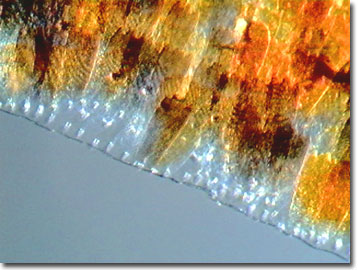Butterfly Wing Scale Digital Image Gallery
Four-Bar Swallowtail Butterfly
Ironically, because the four-bar swallowtail butterfly has an extremely short adult lifespan and only produces a single brood per year, the species was not officially included in the modern faunal lists of China until 1994. However, human population growth, commercial exploitation, and forest destruction had already begun shrinking the crucial habitats of the species. In Cambodia and Laos, the ephemeral four-bar swallowtail butterfly is considered an endangered species.

Scientifically described as Graphium agetes, this lepidopteran is sometimes known as the four-bar swordtail because of a very long pair of extensions projecting from its hind wings. The representative of the Papilionidae family features four black bars against a creamy green background on both sides of its forewings that continue down onto its hind wings. The bar pattern is visible both when the butterfly is at rest and when it is in flight. Unlike closely related species of swordtail butterflies, the four-bar swallowtail butterfly features a conspicuous large red spot where the upper surfaces of its hind wings join and several other red wing markings. The unusual splotches of color likely aid in species recognition and help prevent hybridization in the wild.
The egg-laying habits of the female four-bar swallowtail appear unique in the insect world. The host plant they prefer is Fissistigma oldhamii, a medicinal plant that contains pharmaceutically active compounds. Since the immature leaves of the host plant are folded, the mated female must be able to pry open the leaf halves with her abdomen in order to lay and embed one or two creamy white eggs. If she does not succeed, she moves on and tries another leaf. In fact, females are known to spend hours searching by trial-and-error for suitable leaves on the host plant for egg deposition. By placing her eggs on the mid-leaf veins of unsplit immature leaves, the protective mother provides a small degree of safety from predators to her offspring.
Ranging throughout India and Southeast Asia, the four-bar swallowtail butterfly is represented by five scientifically described subspecies. Prized by collectors for their rarity and beautiful wings, some local populations are feeling the pressures of a growing worldwide demand. Four-bar swallowtails are strong, extremely fast fliers that usually feed on flowering trees high up in the tree canopy. However, males repeatedly retrace their flight circuits and are susceptible to capture by collectors when they stop to sip fluids and minerals from puddles. Females are susceptible to capture when they come out of the canopy to lay their eggs on host plants, which are only about 2 meters above the ground.
Contributing Authors
Cynthia D. Kelly, Shannon H. Neaves, Laurence D. Zuckerman, and Michael W. Davidson - National High Magnetic Field Laboratory, 1800 East Paul Dirac Dr., The Florida State University, Tallahassee, Florida, 32310.
BACK TO THE BUTTERFLY WING SCALE IMAGE GALLERY
BACK TO THE DIGITAL IMAGE GALLERIES
Questions or comments? Send us an email.
© 1995-2025 by Michael W. Davidson and The Florida State University. All Rights Reserved. No images, graphics, software, scripts, or applets may be reproduced or used in any manner without permission from the copyright holders. Use of this website means you agree to all of the Legal Terms and Conditions set forth by the owners.
This website is maintained by our
Graphics & Web Programming Team
in collaboration with Optical Microscopy at the
National High Magnetic Field Laboratory.
Last Modification Friday, Nov 13, 2015 at 01:19 PM
Access Count Since January 21, 2003: 8788
Visit the website of our partner in introductory microscopy education:
|
|
